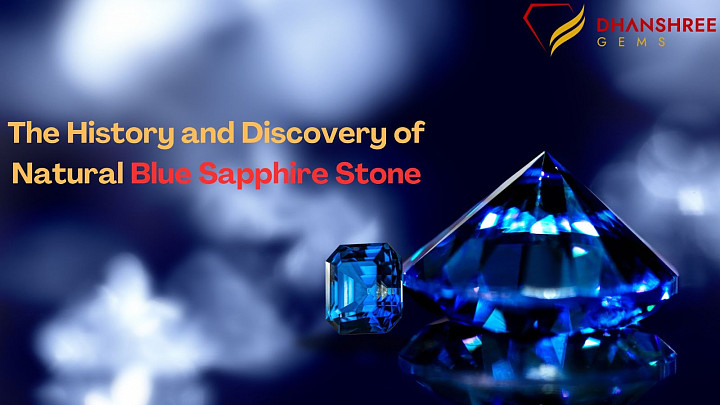The History and Discovery of Natural Blue Sapphire Stone

For thousands of years, people have been enthralled with blue sapphires stones due to their captivating deep blue color. Throughout history, people from all nations and civilizations have valued, sought for, and worshiped these priceless gemstones. There is mystery, beauty, and allure associated with blue sapphires, from prehistoric tales to contemporary jewelry. This blog delves into the fascinating discovery and history of naturally occurring blue sapphire stones, highlighting their importance and attraction.
The Ancient World and Blue Sapphires
The Latin word "sapphirus" and the Greek word "sappheiros," both of which imply "blue stone," are the sources of the word "sapphire." were considered to represent the skies and to offer protection, knowledge, and heavenly favor in prehistoric times. They represented strength and purity, and were prized by the nobility and elite.
Ancient Persia: In ancient Persian culture, it was believed that the earth rested on a giant blue sapphire, and the sky was a reflection of its beautiful color. Sapphires were considered sacred and were associated with celestial harmony.
Ancient Greece and Rome: The Greeks and Romans wore sapphires as amulets to protect them from harm and envy. The stones were also believed to bring favor from the gods, especially for oracles and seers. They played a significant role in religious and spiritual practices.
India: In Hindu culture, sapphires were revered as powerful stones associated with Saturn, or "Shani," and were believed to bring good fortune, wealth, and spiritual enlightenment. They were often worn by the rulers and priests as a symbol of divine favor.
The Medieval and Renaissance Eras
Sapphires became popular in Europe during the Middle Ages, particularly with the nobility and clergy. They were a popular option for church rings and jewelry since they were thought to represent heaven. Blue sapphires were believed to assure faithfulness, maintain chastity, and shield users from harm and jealousy.
The Church and Royalty: Sapphires adorned religious icons and crowns. Kings and queens would often use them in their regalia to symbolize divine favor and wisdom. The famous engagement ring of Princess Diana, now worn by Kate Middleton, features a stunning blue sapphire, continuing the tradition of royal association.
Medieval Lore: According to medieval lore, sapphires had the power to detect poison. It was believed that a sapphire placed in a goblet would react if poison was present, making them a popular choice for goblets and drinking vessels among the nobility.
The Discovery of Blue Sapphires
The story of blue sapphires, from their origins in the soil to their use in contemporary jewelry and royal crowns, is one of exploration, trade, and discovery.
Sri Lanka (Ceylon): One of the earliest and most famous sources of blue sapphires is Sri Lanka, historically known as Ceylon. The island has been a renowned source of these gemstones for over 2,000 years. Ancient travelers, including Marco Polo, spoke of the island’s wealth in gemstones. The sapphires from Sri Lanka are known for their vibrant, light to medium blue hues, often referred to as "Ceylon sapphires."
Kashmir: In the late 19th century, spectacular blue sapphires were discovered in the Kashmir region of India. These sapphires, characterized by their velvety blue color and exceptional quality, are considered some of the finest in the world. The discovery in Kashmir led to a sapphire rush, but the mines were soon depleted, making these gems extremely rare and valuable.
Myanmar (Burma): Myanmar, formerly known as Burma, is another significant source of high-quality sapphires. Burmese sapphires are renowned for their deep, rich blue color and have been highly prized throughout history.
Thailand and Australia: Sapphires were discovered in the 20th century in Thailand and Australia. The Thai sapphires are often darker and more inky blue, while Australian sapphires can range from blue-green to deep blue.
Madagascar: In recent years, Madagascar has become a significant source of sapphires. The discovery of high-quality blue sapphires in Madagascar has added to the island’s reputation as a treasure trove of gemstones, supplying a large portion of the world’s sapphires today.
Blue Sapphires in Modern Times
Blue sapphires are still among the most sought-after and well-liked gemstones today. They are prized for their durability, beauty, and meaning. Sapphires are a popular choice for engagement rings since they stand for sincerity, commitment, and trust. They are also a well-liked option for a variety of jewelry pieces, such as bracelets, earrings, and necklaces.
Symbolism and Significance: Beyond their beauty, blue sapphires are still associated with wisdom, protection, and good fortune. They are believed to enhance mental clarity, self-discipline, and spiritual growth.
Technological Advancements: Modern gemology has allowed for the enhancement and treatment of sapphires to improve their color and clarity. Heat treatment is a common practice that enhances the blue color of sapphires, making them more vibrant and appealing to consumers.
Conclusion
Natural blue sapphire stones' discovery and history provide witness to their ageless appeal and enduring significance. Power, protection, and beauty have been symbolized by these alluring gemstones from the dawn of civilization to the present day. Blue sapphires are still a shining source of mystery and beauty, whether they are set in jewelry collections of aficionados or worn on the crowns of kings. for many years to come, their journey from the bottom of the earth to the pinnacles of human adoration will captivate and inspire people.
